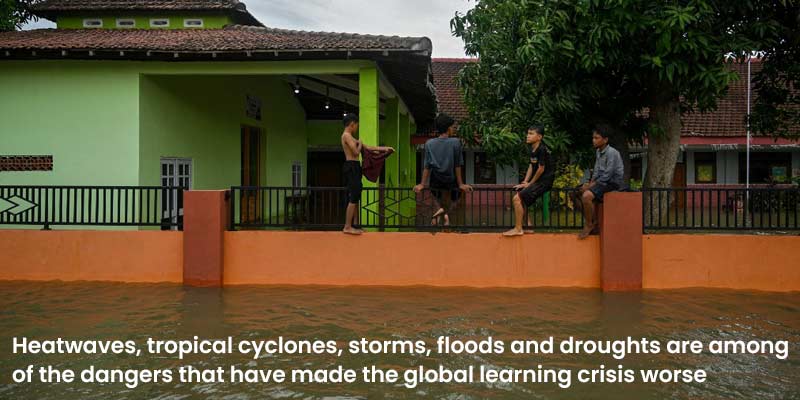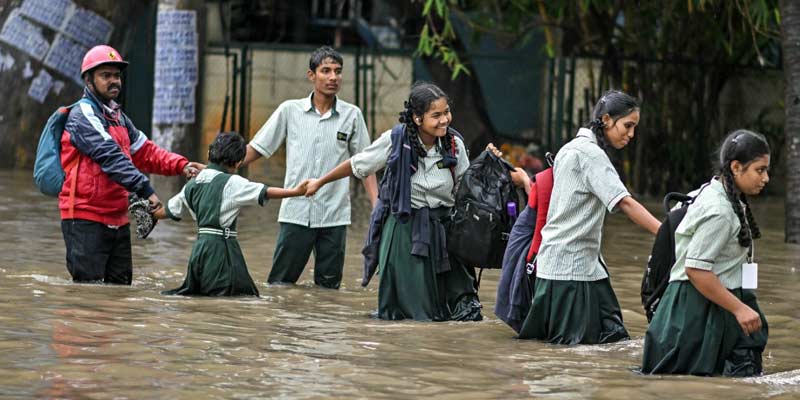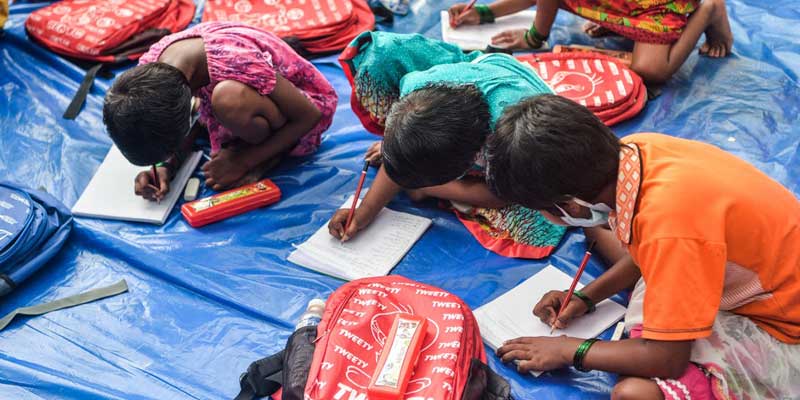- World
- Jan 25
Explainer - How climate change disrupts education?
• At least 242 million children in 85 countries had their schooling disrupted by extreme climate events including heatwaves, tropical cyclones, storms, floods, and droughts in 2024, shows a UNICEF report.
• The report mentioned that over five crore students in India were affected in 2024.
• ‘Learning Interrupted: Global Snapshot of Climate-Related School Disruptions in 2024’ examines climate hazards that resulted in either school closures or the significant interruption of school timetables, and the subsequent impact on children from pre-primary to upper secondary level.
How climate change disrupts education?
• Climate change is deepening the global learning crisis and threatening children’s ability to learn. Right now, an estimated two thirds of children around the world cannot read with comprehension by age 10. Climate hazards are exacerbating this reality.
• Nearly half the world’s children – approximately one billion children – live in countries with extremely high risks of climate and environmental shocks.
• Climate change disrupts education at all levels, having a devastating impact on children, communities, and societies. Extreme climate events shatter education systems and hinder teaching, exacerbating the global learning crisis.
• At the community level, climate hazards damage school infrastructure, often forcing schools to serve as shelters for displaced families, further limiting access to education.
• Individually, children bear the heaviest burden, facing not only disrupted learning but also increased risks of physical harm and mental health issues. These challenges deprive children of their right to learn, and place added stress on parents, caregivers and teachers, further deepening vulnerabilities in communities impacted by conflict, displacement and migration.
• Rising temperatures, storms, floods, and other climate hazards can damage school infrastructure and supplies, hamper routes to school, lead to unsafe learning conditions, and impact students’ concentration, memory, and mental and physical health.
• Education is one of the most frequently disrupted services due to climate-related events, yet it is often overlooked in policy discussions, despite its crucial role in climate change mitigation and adaptation.
• Schools and education systems are ill-equipped to protect students from the impacts of climate change, particularly in fragile contexts, and climate finance investments in education remain strikingly low.
• In fragile contexts, prolonged school closures make it less likely for students to return to the classroom and place them at heightened risk of child marriage and child labour.
• Evidence shows that girls are often disproportionately affected, facing increased risks of dropping out of school and gender-based violence during and after disasters.
• Globally, education systems were already failing millions of children. A lack of trained teachers, overcrowded classrooms, and differences in the quality of – and access to – education have long been creating a learning crisis that climate hazards are exacerbating.
Key points of the report:
• At least one in seven students had their schooling disrupted due to climate hazards in 2024.
• In 2024, as many as 85 countries or territories saw their schools affected by climate-related hazards, with 23 countries experiencing multiple rounds of school closures.
• At least 20 countries had nationwide school disruptions in 2024 due to climate-induced disasters. Heatwaves, tropical cyclones, storms, and floods — all exacerbated by climate change — were causing nationwide school closures in 2024.
• At least 74 per cent of the 242 million affected students are in low and lower-middle-income countries, with an average Children’s Climate Risk Index (CCRI) score of 7 out of 10.
• South Asia was the most affected region in 2024 with 128 million students affected by climate-related school disruptions. East Asia and the Pacific region followed, impacting 50 million students.
• In 2024, heatwaves were the most significant climate hazard worldwide to disrupt schooling, affecting an estimated 171 million students.
• April saw the highest global climate-related school disruptions, with heatwave as the leading hazard affecting at least 118 million children in Bangladesh, Cambodia, India, the Philippines, and Thailand.
• September recorded the most frequent climate-related school disruptions. At a time of year when schools reopen in many parts of the world, at least 18 countries suspended classes. Typhoon Yagi affected 16 million children in East Asia and the Pacific, making it the top hazard in September.
• In Africa, while over 107 million children are already out of school, climate-related disruptions in 2024 have put an additional 20 million children at risk of dropping out.
Scenario in India
• India is extremely vulnerable to the adverse impacts of climate change, ranking 26 out of 163 countries in the UNICEF Children’s Climate Risk Index of 2021.
• In India, 5.47 crore students were affected by climate-related school disruptions last year.
• Heatwave was the major climate hazard causing the largest school disruption.
• Fast-onset hazards such as flooding, landslides and cyclones have repeatedly caused destruction to schools while environmental stressors like extreme heat and air pollution are harming children’s health and hindering their school attendance and learning outcomes.
• With UNICEF’s advocacy, the government has integrated elements of climate change in the National Curriculum Framework — a national guide to developing state curriculum, textbook content and teaching
learning practices. At the state level, UNICEF is working with the government to implement Comprehensive School Safety Programmes (CSSP) across 12 states.
• These programmes integrate elements of climate change, focusing on safe school learning environments and empowering children as agents of change.
• In 2024 alone, over 121,000 educators were trained under these programmes. To further enhance teachers’ capacity in climate change education, a national teacher training module developed with UNICEF’s support, is set to be finalized in March 2025.
Recommendations by UNICEF
• Protect children by explicitly integrating climate change education in education systems and addressing the impacts of climate change on education in national policies and plans including countries’ Nationally Determined Contributions, National Adaptation Plans and Education Sector Plans.
• Increase financing to improve the climate resiliency of the education sector, including investment in scaling up proven and promising solutions focused on:
i) Climate-resilient schools for greener and safer learning.
ii) Climate-resilient education systems that deliberately mainstream climate in national school curricula, and in teacher development programmes and policies.
iii) Youth-led climate action that builds resilience at local level, engaging schools and community leaders.
• Strengthen systemic and robust data collection on the impacts of climate events on education and learning disruptions. This should include establishing climate, environment and school closure monitoring systems at the country level.
Manorama Yearbook app is now available on Google Play Store and iOS App Store



